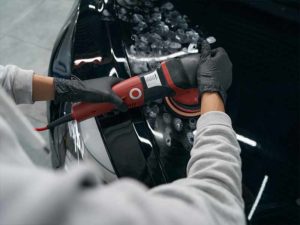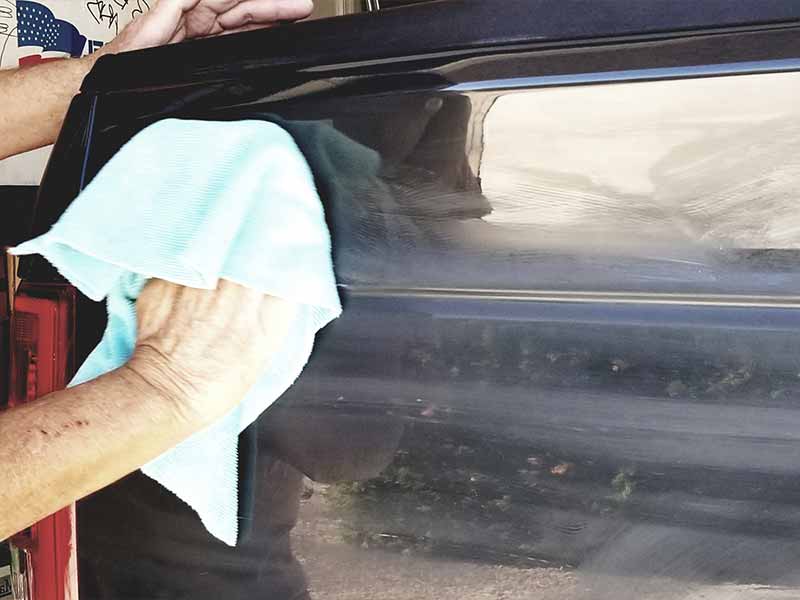Table of Contents
Most detailers are looking for the most efficient way to get the best results. We all want shinier and cleaner cars, but it’s hard to find the right products that won’t waste your time or money.
In an effort to remove some stress, we put together this helpful guide that talks about polishing pads and finishing pads. We’ll describe both options, how they differ, some similarities, and which product is right for you. By the end of this piece, you should better understand the optimal way to get your vehicle shiny.
Polishing Pad Vs Finishing Pad
Polishing pads are for polishing out swirl marks and light scratches in car paint, as well as removing light oxidation. Finishing pads are for applying carnauba wax or paint sealant to the surface of your paintwork.
The difference between polishing and finishing pads is the firmness of the pad. Polishing pads are slightly firmer than finishing pads. The extra firmness of a polishing pad helps the polishing compound work more effectively at removing paint defects.
Finishing pads are very soft to help reduce friction heat between the pad and the clear coat of your vehicle. They are designed to make it easier to apply wax or sealants without removing any clear coat from the paint surface.
What Is a Polishing Pad?
A polishing pad is definitely the more popular of the two. This is used on a polisher in order to get rid of surface-level defects on your car’s topcoat. At the same time, it adds a level of sheen to your vehicle.
The pad is usually circular with a clearly defined “front” and “rear” of the pad. The front comes in contact with your car with a layer of polishing solution between the two. The rear gets installed on the polisher to join the two together.
Polishing pads are used to polish a car. This refers to cutting off a thin layer of your topcoat in order to create a uniform layer that adds a level of shine to your car.

What Is a Finishing Pad?
The geometry of a finishing pad is very similar. This is another option that can be used with a polisher, and it’s used to “finish” your car. This term refers to adding a high level of gloss to your vehicle.
When you see an exceptionally shiny car at an auction or on a showroom floor, there’s a good chance that it was finished ahead of time.
Typically, the everyday driver won’t spend time finishing their daily driver. Finishing a car works a lot like waxing it, but it results in a shinier, mirror-like gloss in the end.
If you think about these pads in terms of sandpaper, a finishing pad would have the finest level of grit. In other words, it would take off the least amount of material and provide the smallest amount of friction.
These pads are mostly used to distribute finishing solution on your car. They won’t cut into the topcoat or remove any defects on your vehicle. They are intended to be a version of an applicator pad that you might use to hand wax a vehicle — except finishing pads are designed to be used on an automatic polishing hand tool.

Differences Between a Polishing Pad and a Finishing Pad
To better describe how these two pads differ, we’ll talk about some of the main categories that they differ. This section is all about the differences between a polishing pad and a finishing pad.
The Level of Cut
A polishing pad needs to cut deeper than a finishing pad. Detailers will use a polishing pad to get rid of some minor surface damages like swirls, scratches, and marks.
With finishing pads, the purpose is just to give a very shiny layer with the help of some polishing agents. For that, you won’t need to cut into the topcoat.
For reference, “cutting” refers to how much of the topcoat gets removed during the buffing process. The topcoat of your car is a clear layer of protective material. Over time, the topcoat will wear out and develop some surface-level defects.
When this happens, your car will look dull. Once you polish your car, the topcoat gets restored by removing the defects on the surface. Instead, you’ll be left with a uniform layer of topcoat which will create a shinier look.
To simplify the explanation, polishing pads will cut your topcoat for a shiny look while a finishing pad will not.
Pad Density
If you have a polishing and a finishing pad on a table, you probably won’t notice a difference. They might be a different color, but they’ll otherwise be identical.
So, how can these pads be so different? It’s all about the density and stiffness of the material used. Yes, both pads use a foam material, but polishing pads will be more dense and stiffer.
If you were to touch both pads, the finishing pad will be noticeably softer and squishier.
Their Intended Use
The biggest difference is that these pads are intended for different uses altogether. A finishing pad should only be used to give your car an extra level of shininess. The pad acts as an applicator with very little cutting power. Instead of altering the topcoat, the pad should be used to put on a high-quality finishing product.
After finishing your car, you’ll have a showroom-ready vehicle. Typically, the everyday detailer doesn’t use finishing pads very often.
Instead, they’ll usually use polishing pads. You can think of a polishing pad as a not-so-shiny version of a finishing pad. It will still give your car a good level of shine, but it can’t deliver the same results that a finishing pad can.
As we mentioned, a polishing pad will cut a thin layer of your topcoat. Doing this will give you a more uniform layer of your clear coat which ultimately makes your car look shinier. It also removes surface-level defects, essentially erasing light scratches on your car.
When you hear someone say, “that will buff right out”, they’re referring to using a polishing pad or compounding pad to remove the layer of topcoat in which the scratch is residing.
Color Used
Generally, both pads will be a different color. This is one way for a detailer to tell the two apart without picking them up and handling them.
The idea is that you should be able to immediately tell which pad is which as they’re sitting alongside one another on a shelf.

Similarities Between a Polishing Pad and Finishing Pad
While these pads are very different, they have a few major similarities. In this section, we’ll highlight some of the bigger similarities.
Material Composition
First off, both pads are made out of foam in this case. We mentioned earlier that the stiffness is why they can offer different levels of cutting, but the material is unchanged between the two.
They both use a form of foam, but the manufacturing and pre-processing steps are very different.
When They’re Used
Even though both pads are used for different purposes, they’re both used at the same time. After washing your car, you can either polish or finish it.
You shouldn’t use either pad after waxing. Why? The polishing or finishing pad will simply remove the wax that you just applied.
Both pads will be used after washing your car. If you want to polish and finish your car, you would polish first and finish after.
It’s also worth mentioning that neither pad should be used on a dirty car. The dirt and debris on your vehicle can do some real damage to your topcoat as the polisher spins around.
Used on the Same Tool
Both of these pads can be used on an orbital or dual-action polisher. You will just need to ensure the mounting style is the same between the pad and your tool.
If you are looking to polish and finish your car, it helps to have both pads use the same mounting style. For example, if both have Velcro on the back, you can quickly swap out your pads and complete the project.
Otherwise, you would need a second polisher which would be a waste of money.
Which Pad Should You Use?
Finally, let’s discuss which pad is right for you. By this point, you should have a good idea of how each of these pads works and some of the major differences.
If you’re a typical car owner, you probably don’t have a use for a finishing pad. The truth is that the added level of shininess you achieve by finishing your car will quickly fade as you commute and drive around.
Instead, we’d suggest just polishing or waxing your car. Remember, finishing is performed after polishing, so you’d have to polish your car either way. It’s tough to justify the extra step just to get that added level of sheen.
For professional detailers, collectors, car salesmen, and enthusiasts, both pads are necessary. The polishing pad will create a good base, and the finishing pad will give you the best possible shine after. They should both be used to make the car look as presentable as possible.
Since there’s no functional overlap, you can’t get away with just owning one pad or the other if you want a professionally shiny car.










